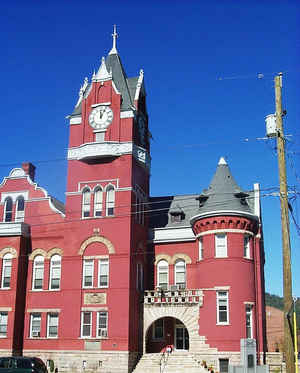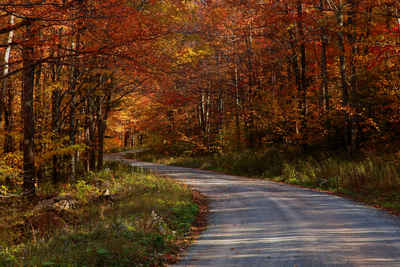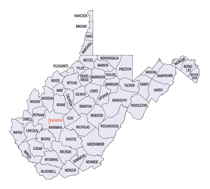West Virginia Counties
There are fifty-five counties in the state of West Virginia. Fifty of them existed at the time of the Wheeling Convention in 1861, before which West Virginia was part of the state of Virginia. The remaining five (Grant, Mineral, Lincoln, Summers and Mingo) were formed within the state after its admission to the United States on June 20, 1863. At that time, Berkeley County and Jefferson County, the two easternmost counties of West Virginia, refused to recognize their inclusion in the state. In March 1866, the US Congress passed a joint mandate assenting to their inclusion.Tucker County, West Virginia
Tucker County Education, Geography, and History

Tucker County is a county located in the state of West Virginia. Based on the 2010 census, the population was 7,141, making it the second-least populous county in West Virginia. Its county seat is Parsons. The county was created in 1856 from a part of Randolph County, then part of Virginia. In 1871, a small part of Barbour County, was transferred to Tucker County. The county was named after Henry St. George Tucker, Sr., a judge and Congressman from Williamsburg, Virginia.
Etymology - Origin of Tucker County Name
For Henry S. George Tucker (1780-1848), an eminent jurist and statesman of Virginia
Demographics:
County QuickFacts: CensusBureau Quick Facts
Early History of Tucker County, West Virginia
Tucker County was created by an act of the Virginia General Assembly on March 7, 1856 from parts of Randolph County. According to the 1860 census, there were only 245 families, and 16 slaves, living in the county at that time.
The county was named in honor of Henry St. George Tucker, Sr. (1780-1848). He was born on December 29, 1780 in Williamsburg, Virginia. He graduated from William and Mary College, studied the law, and became a prominent Virginia jurist. He enlisted in the Continental Army during the War of 1812 and rose to the rank of Brigadier General of the Virginia State Militia. He later represented Virginia in the US House of Representatives (1815-1819), served as a superior court judge (1824-1831), President of the Virginia Supreme Court of Appeals (1831-1841), and Dean of the faculty at the University of Virginia (1841-1845). He died on August 28, 1848.
Samuel and John Pringle were the first Englishmen to set foot on the present site of Tucker County. In 1764, they passed through the county after deserting their post at Fort Pitt in 1761 (Pittsburgh). In 1766, John Couch became the first settler in the present county. He stayed six years before moving to Tygart Valley to join his two brothers who had settled there in 1772. In 1769, Christopher Neugen settled near Holly Meadows, lived there awhile and then moved away. Thomas Howell, who had been captured by Indians and taken beyond the Ohio River, passed through the present county in the early 1770s (probably 1771) after escaping and making his way through the wilderness back to Virginia. He died soon after reaching the settlements in Virginia.
Thomas Parsons, a prominent citizen who lived near Moorefield, listened to Howell's tales of a beautiful valley he had passed through and decided to see it for himself. In about 1773, he traveled over the mountains and visited the present site of Tucker County. After claiming the land, his two sons, Thomas, Jr. (1730-1804) and James (1740-1813), moved to the present county in 1774. In March 1774, John Minear (1732-1781) and about a dozen families also moved into the present county, near St. George. However, that summer Lord Dunmore's War broke out and, fearing for their lives, all of the settlers abandoned the county for nearly two years, returning in even larger numbers in 1776.
Tragedy struck the county's early settlers in April 1781 when three of its leading citizens, John Minear, Daniel Cameron and Jacob Cooper, were killed by Indians as they returned to their homes from Clarksburg to obtain legal patents for their lands.
The act creating the county specified that the county court was to be held on the lands of Enoch Minear on the east side of Cheat River, and was to be called Saint George (the area had been known as Westernford) in honor of Henry Saint George Tucker, Jr. (1828-1863), son of the county's namesake who had a distinguished military career, rising to the rank of Lieutenant-Colonel in the Confederate Army. He died in 1863 from a fever at the Battle of Malvern Hill during the Civil War. He was serving as the clerk of the House of Delegates when the county was formed.
The first officer killed during the Civil War (Confederate General Robert S. Garnett) died at the Battle of Corrick's Ford, near Parsons, on July 13, 1861. Parsons, the current county seat, was named for Ward Parsons. He owned the land the town was built on. The town was incorporated by the West Virginia state legislature in 1893.
Geography: Land and Water
As reported by the Census Bureau, the county has a total area of 421 square miles (1,090 km2), of which 419 square miles (1,090 km2) is land and 2.1 square miles (5.4 km2) (0.5%) is water
Neighboring Counties
Bordering counties are as follows:
- North: Preston County
- East: Grant County
- Southwest: Randolph County
- West: Barbour County
Education







